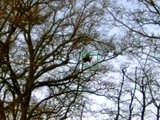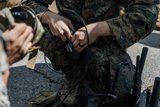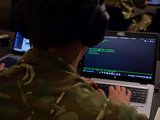Lockheed Martin working on new AESA radar
Lockheed Martin has introduced an active electronically scanned array (AESA) radar demonstrator for engagement and surveillance as part of work to develop a next generation air and missile defence sensor.
The demonstrator is a representative full-scale prototype of the technology to support a modern, 360 degree capable sensor that the US Army will use to address current and emerging air and ballistic missile threats.
This fractional array is representative of Lockheed Martin's potential Lower Tier Air and Missile Defense Sensor solution, built on a modular and scalable architecture to scale to the army's requirements - once finalised - to replace the aging Patriot MPQ-65 radar. The array will be used to mature technology and verify performance to ensure uniform 360 degree threat detection and system performance.
Lockheed Martin's AESA technology incorporates gallium nirtride (GaN) transmitter technology and advanced signal processing. These technologies and concepts have been fully integrated into both demonstration and production systems and are also in use in the AN/TP/Q-53 radar system.
Mark Mekker, director of next generation radar systems at Lockheed Martin, said: ‘Incremental upgrades to the existing Patriot radar no longer address current sustainment issues, current threat performance shortcomings, or provide growth for future and evolving threats.
‘Lockheed Martin is prepared to offer a next generation missile defence system that will leverage advances in radar technology to provide a modular, scalable architecture and reduce the total cost of ownership well over its 30 year lifecycle.’
Related Equipment in Defence Insight
More from Digital Battlespace
-
![Chess Dynamics successfully demonstrates Vision4ce AI-driven tracker]()
Chess Dynamics successfully demonstrates Vision4ce AI-driven tracker
The Vision4ce Deep Embedded Feature Tracking (DEFT) technology software is designed to process video and images by blending traditional computer vision with artificial intelligence (AI) algorithms to present actionable information from complex environments.
-
![Wave Relay devices cleared for security use on commercial systems in industry trend]()
Wave Relay devices cleared for security use on commercial systems in industry trend
Persistent Systems has been cleared by National Security Agency (NSA) to transmit sensitive data on commercial networks. The devices are added to the NSA’s Commercial Solutions for Classified (CSfC) component list which also includes other companies’ products providing the same security.
-
![UK teases cyber spending boost in Strategic Defence Review ahead of “imminent” release]()
UK teases cyber spending boost in Strategic Defence Review ahead of “imminent” release
The release of the UK’s Strategic Defence Review (SDR) has been long promised as mid-year. It is possible it could be as early as 2 June although the UK Ministry of Defence (MoD) continues to play its cards close to its chest.
-
![Intelsat emphasises SATCOM resilience for SOF in contested domains (video)]()
Intelsat emphasises SATCOM resilience for SOF in contested domains (video)
Intelsat outlines how its multi-orbit SATCOM architecture is enhancing connectivity and resilience for special operations forces operating in degraded and contested environments.
-
![US Space Force’s next-generation missile warning system moves forward with $500 million in new contracts]()
US Space Force’s next-generation missile warning system moves forward with $500 million in new contracts
Next-Generation Overhead Persistent Infrared (Next-Gen OPIR) satellites are intended to provide early warning of missile launches from any location worldwide and new ground stations will result in expanded coverage of critical missile warning.























